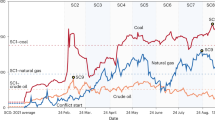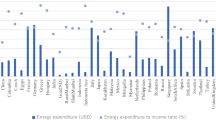Abstract
Inequality in energy consumption, both direct and indirect, affects the distribution of benefits that result from energy use. Detailed measures of this inequality are required to ensure an equitable and just energy transition. Here we calculate final energy footprints; that is, the energy embodied in goods and services across income classes in 86 countries, both highly industrialized and developing. We analyse the energy intensity of goods and services used by different income groups, as well as their income elasticity of demand. We find that inequality in the distribution of energy footprints varies across different goods and services. Energy-intensive goods tend to be more elastic, leading to higher energy footprints of high-income individuals. Our results consequently expose large inequality in international energy footprints: the consumption share of the bottom half of the population is less than 20% of final energy footprints, which in turn is less than what the top 5% consume.
This is a preview of subscription content, access via your institution
Access options
Access Nature and 54 other Nature Portfolio journals
Get Nature+, our best-value online-access subscription
$29.99 / 30 days
cancel any time
Subscribe to this journal
Receive 12 digital issues and online access to articles
$119.00 per year
only $9.92 per issue
Buy this article
- Purchase on Springer Link
- Instant access to full article PDF
Prices may be subject to local taxes which are calculated during checkout






Similar content being viewed by others
Data availability
The expenditure data used is available at http://datatopics.worldbank.org/consumption/ and https://ec.europa.eu/eurostat/data/database. The IEA data can be downloaded under institutional license from the UK data service at https://stats2.digitalresources.jisc.ac.uk/ and https://doi.org/10.5257/iea/web/2018-10. The underlying GTAP 9 database can be purchased from https://www.gtap.agecon.purdue.edu/databases/v9/default.asp. The concordance matrices used in the footprint calculations are depicted in the Supplementary Tables 3 and 4. The final energy footprint data per consumption category, nation and income group as well as energy intensities, elasticities and scenario parameters are available from the corresponding author on reasonable request. Source data for Figures 1 to 6 are provided with the paper.
Code availability
MATLAB code for obtaining final energy footprints from the MRIO and calculating elasticities and the Gini coefficient is available at https://github.com/eeyouol.
Change history
30 March 2020
A Correction to this paper has been published: https://doi.org/10.1038/s41560-020-0606-9
References
Alvaredo, F., Chancel, L., Piketty, T., Saez, E. & Zucman, G. World Inequality Report 2018 (World Inequality Lab, 2018).
Reward Work, Not Wealth (Oxfam, 2018).
Hubacek, K., Baiocchi, G., Feng, K., Sun, L. & Xue, J. Global carbon inequality. Energy, Ecol. Environ. 2, 361–369 (2017).
Krieger, T. & Meierrieks, D. Income inequality, redistribution and domestic terrorism. World Dev. 116, 125–136 (2019).
Rockström, J. et al. A roadmap for rapid decarbonization. Science 355, 1269–1271 (2017).
Steffen, W. et al. Trajectories of the Earth system in the Anthropocene. Proc. Natl Acad. Sci. USA. 115, 1–45 (2018).
Teixidó-Figueras, J. et al. International inequality of environmental pressures: decomposition and comparative analysis. Ecol. Indic. 62, 163–173 (2016).
Steinberger, J. K., Krausmann, F. & Eisenmenger, N. Global patterns of materials use: a socioeconomic and geophysical analysis. Ecol. Econ. 69, 1148–1158 (2010).
Ivanova, D. et al. Environmental impact assessment of household consumption. J. Ind. Ecol. 20, 526–536 (2015).
Galvin, R. & Sunikka-blank, M. Economic inequality and household energy consumption in high-income countries: a challenge for social science based energy research. Ecol. Econ. 153, 78–88 (2018).
Creutzig, F. et al. Towards demand-side solutions for mitigating climate change. Nat. Clim. Chang. 8, 268–271 (2018).
Baker, L. Of embodied emissions and inequality: Rethinking energy consumption. Energy Res. Soc. Sci. 36, 52–60 (2018).
Grubler, A. et al. A low energy demand scenario for meeting the 1.5 °C target and sustainable development goals without negative emission technologies. Nat. Energy 3, 515–527 (2018).
Shove, E. & Walker, G. What is energy for? Social practice and energy demand. Theory, Cult. Soc. 31, 41–58 (2014).
Fell, M. J. Energy services: a conceptual review. Energy Res. Soc. Sci. 27, 129–140 (2017).
Shue, H. Subsistence emissions and luxury emissions. Law Policy 15, 39–59 (1993).
Access to Electricity (% of Population) (World Bank, 2019); https://data.worldbank.org/indicator/eg.elc.accs.zs
Hubacek, K., Baiocchi, G., Feng, K. & Patwardhan, A. Poverty eradication in a carbon constrained world. Nat. Commun. 8, 912 (2017).
Scherer, L. et al. Trade-offs between social and environmental sustainable development goals. Environ. Sci. Policy 90, 65–72 (2018).
Lamb, W. F. & Rao, N. D. Human development in a climate-constrained world: what the past says about the future. Glob. Environ. Chang. 33, 14–22 (2015).
Rao, N. D. & Min, J. Decent living standards: material prerequisites for human wellbeing. Soc. Indic. Res. 138, 225–244 (2018).
Goldemberg, J. Basic needs and much more with one kilowatt per capita. A J. Hum. Environ. 14, 190–200 (1985).
Jess, A. What might be the energy demand and energy mix to reconcile the world’s pursuit of welfare and happiness with the necessity to preserve the integrity of the biosphere? Energy Policy 38, 4663–4678 (2010).
Chakravarty, S. et al. Sharing global CO2 emission reductions among one billion high emitters. Proc. Natl Acad. Sci. USA 106, 1–5 (2009).
Rao, N. D., Min, J. & Mastrucci, A. Energy requirements for decent living in India, Brazil and South Africa. Nat. Energy 4, 1025–1032 (2019).
Owen, A., Scott, K. & Barrett, J. Identifying critical supply chains and final products: an input–output approach to exploring the energy–water–food nexus. Appl. Energy 210, 632–642 (2018).
Steinberger, J. K., Timmons Roberts, J., Peters, G. P. & Baiocchi, G. Pathways of human development and carbon emissions embodied in trade. Nat. Clim. Chang. 2, 81–85 (2012).
Wu, X. D., Guo, J. L., Meng, J. & Chen, G. Q. Energy use by globalized economy: total-consumption-based perspective via multi-region input–output accounting. Sci. Total Environ. 662, 65–76 (2019).
Wiedmann, T. O. et al. The material footprint of nations. Proc. Natl Acad. Sci. USA 112, 6271–6276 (2015).
Moran, D. Carbon footprints of 13,000 cities. Environ. Res. Lett. 13, 064041 (2018).
Peters, G. P., Andrew, R. & Lennox, J. Constructing and environmentally-extended multi-regional input–output table using the GTAP database. Econ. Syst. Res. 23, 131–152 (2011).
Global Consumption Database (World Bank, 2018); http://datatopics.worldbank.org/consumption/
Consumption Expenditure of Private Households (hbs) (Eursostat, accessed 1 September 2018); https://ec.europa.eu/eurostat/cache/metadata/en/hbs_esms.htm
Wiedenhofer, D., Lenzen, M. & Steinberger, J. K. Energy requirements of consumption: Urban form, climatic and socio-economic factors, rebounds and their policy implications. Energy Policy 63, 696–707 (2013).
Isreal-Akinbo, S. O., Snowball, J. & Gavin, F. An investigation of multidimensional energy poverty among South African low-income households. S. Afr. J. Econ. 86, 468–487 (2018).
Narasimha, D. R. & Shonali, P. Energy access and living standards: some observations on recent trends. Environ. Res. Lett. 12, (2017).
Brand-Correa, L. I. & Steinberger, J. K. A framework for decoupling human need satisfaction from energy use. Ecol. Econ. 141, 43–52 (2017).
Steinberger, J. K. & Roberts, J. T. From constraint to sufficiency: The decoupling of energy and carbon from human needs, 1975-2005. Ecol. Econ. 70, 425–433 (2010).
Service, U. D. IEA Energy Balances (accessed 1 October 2018); https://stats2.digitalresources.jisc.ac.uk/index.aspx?r=129421&DataSetCode=IEA_CO2_AB
Davis, S. J. et al. Net-zero emissions energy systems. Science 9793, eaas9793 (2018).
Devlin, S. & Bernick, S. Managing Aviation Passenger Demand with a Frequent Flyer Levy (New Economics Foundation, 2015).
Shepherd, A. Zero Carbon Britain: Making it Happen. (Centre for Alternative Technology, 2017).
Alvaredo, F., Chancel, L., Piketty, T., Saez, E. & Zucman, G. The elephant curve of global inequality and growth. AEA Pap. Proc. 108, 103–108 (2018).
Classifications of Expenditure According to Purpose (United Nations, 1999).
Milanovic, B. Global income inequality in numbers: in History and Now. Glob. Policy 4, 198–208 (2013).
Liberati, P. The world distribution of income and its inequality, 1970–2009. Rev. Income Wealth 64, 248–273 (2015).
Lawrence, S., Liu, Q. & Yakovenko, V. M. Global inequality in energy consumption from 1980 to 2010. Entropy 15, 5565–5579 (2013).
Duro, J. A. On the automatic application of inequality indexes in the analysis of the international distribution of environmental indicators. Ecol. Econ. 76, 1–7 (2012).
Miller, R. E. & Blair, P. D. Input–Output Analysis: Foundations and Extensions 2nd edn (Cambridge University Press, 2009); https://doi.org/10.1017/CBO9780511626982
Dorfman, R. A formula for the Gini coefficient. Rev. Econ. Stat. 61, 146–149 (1979).
Deltas, G. The small-sample bias of the Gini coefficient: results and implications for empirical research. Rev. Econ. Stat. 85, 226–234 (2003).
GDP Long-Term Forecast (OECD, accessed 8 October 2019); https://data.oecd.org/gdp/gdp-long-term-forecast.htm
World Population Prospects 2019 (United Nations, accessed 8 October 2019); https://population.un.org/wpp/
GDP (Constant 2010 US$) (World Bank, 2019); https://data.worldbank.org/indicator/NY.GDP.MKTP.KD
Girod, B. & de Haan, P. More or better? A model for changes in household greenhouse gas emissions due to higher income. J. Ind. Ecol. 14, 31–49 (2010).
Min, J. & Rao, N. D. Estimating uncertainty in household energy footprints. J. Ind. Ecol. 22, 1307–1317 (2018).
Acknowledgements
Y.O. is supported by the Leverhulme Trust’s Research Leadership Award ‘Living Well Within Limits’ (RL2016–048) project awarded to J.K.S. J.K.S was partly supported by an International Academic Fellowship of the Leverhulme Trust (IAF-2018–018). The contributions of A.O. were supported by EPSRC Fellowship award EP/R005052/1. We also would like to thank M. Baltruszewicz, J. Vogel, J. Millward-Hopkins, P. Brockway and L. Hardt for helpful discussions.
Author information
Authors and Affiliations
Contributions
Y.O., J.K.S. and A.O. jointly designed the study, sourced the data, designed the analysis and wrote the paper. Y.O. conducted the analysis.
Corresponding author
Ethics declarations
Competing interests
The authors declare no competing interests.
Additional information
Publisher’s note Springer Nature remains neutral with regard to jurisdictional claims in published maps and institutional affiliations.
Supplementary information
Supplementary Information
Supplementary Notes 1–15, Tables 1–9, Figs. 1–9 and refs. 1–5.
Source data
Source Data Fig. 1
Energy footprints per capita, expenditure per capita.
Source Data Fig. 2
Gini coefficients of countries in energy and expenditure.
Source Data Fig. 3
Elasticities and energy intensities per country and consumption category.
Source Data Fig. 4
Population-weighted average of elasticities and energy intensities.
Source Data Fig. 5
Cumulative population and cumulative energy resources needed to generate Lorenz curves, Raw consumption-based energy accounts per country and consumption category.
Source Data Fig. 6
Share of aggregated consumption categories in energy over time, Raw consumption-based energy accounts per country and consumption category with additional business as usual forecasts, OECD given and applied growth forecasts.
Rights and permissions
About this article
Cite this article
Oswald, Y., Owen, A. & Steinberger, J.K. Large inequality in international and intranational energy footprints between income groups and across consumption categories. Nat Energy 5, 231–239 (2020). https://doi.org/10.1038/s41560-020-0579-8
Received:
Accepted:
Published:
Issue Date:
DOI: https://doi.org/10.1038/s41560-020-0579-8
This article is cited by
-
Climate change: the next game changer for sport and exercise psychology
German Journal of Exercise and Sport Research (2024)
-
Differences in energy-saving benefits between the rich and poor: data-driven method to study equity of mandatory energy efficiency policy in Chongqing
Environmental Science and Pollution Research (2024)
-
Underestimations of the income-based ecological footprint inequality
Climatic Change (2024)
-
Emissions savings from equitable energy demand reduction
Nature Energy (2023)
-
Quantifying generational and geographical inequality of climate change
Scientific Reports (2023)



